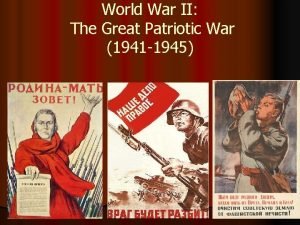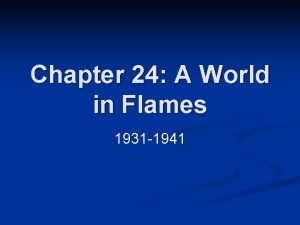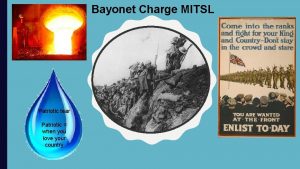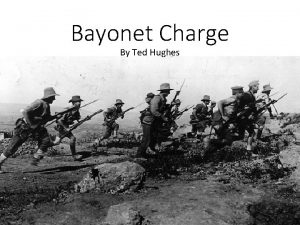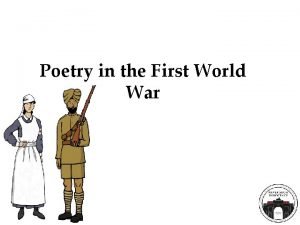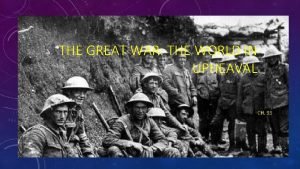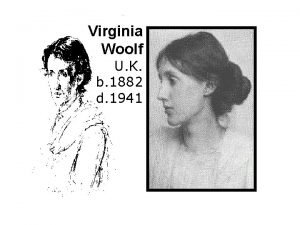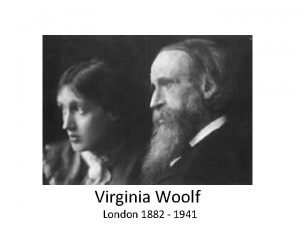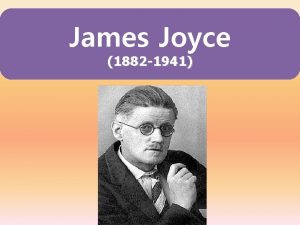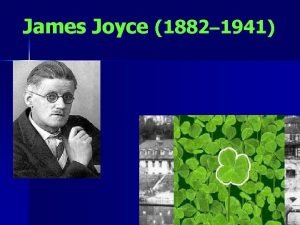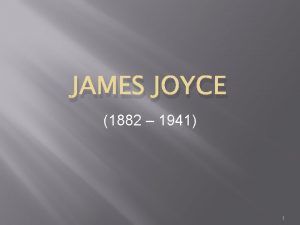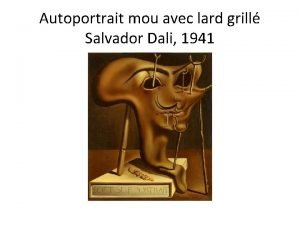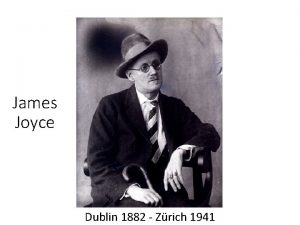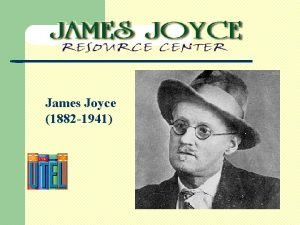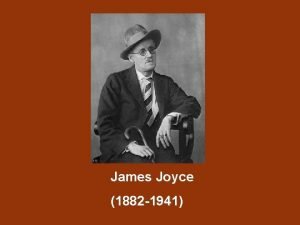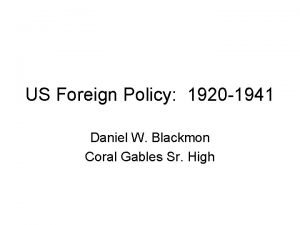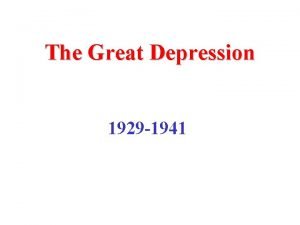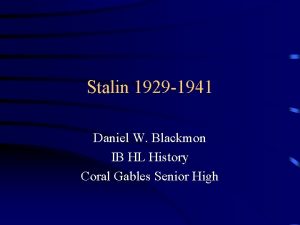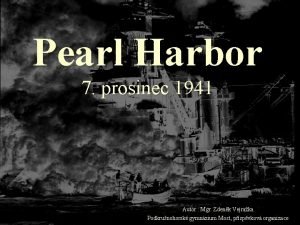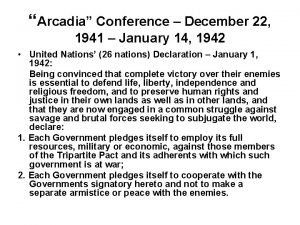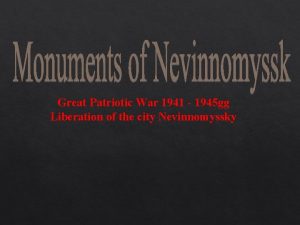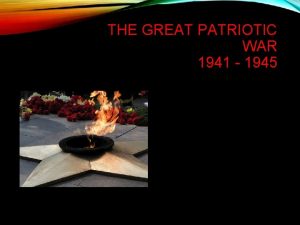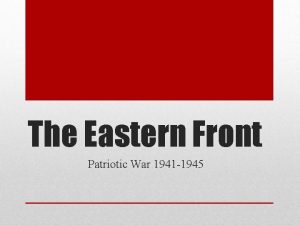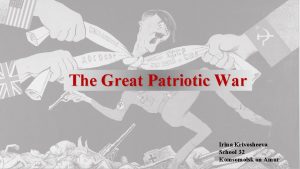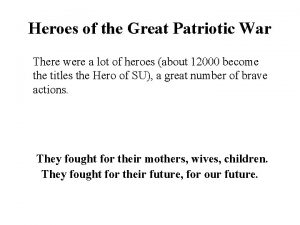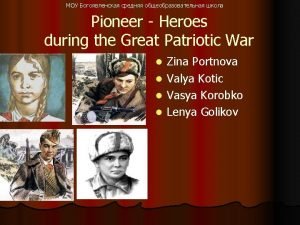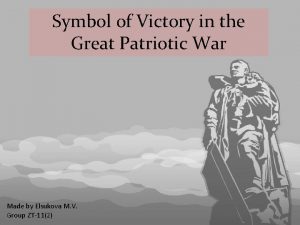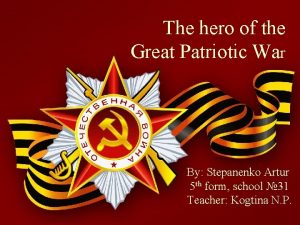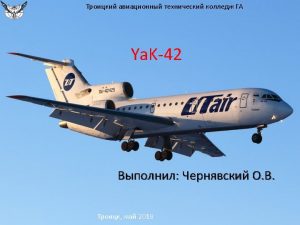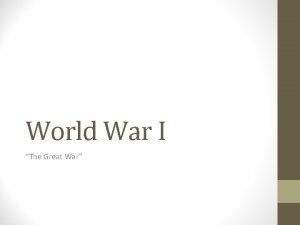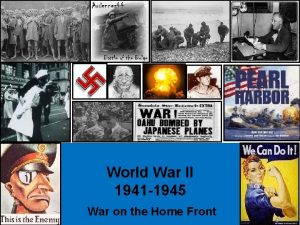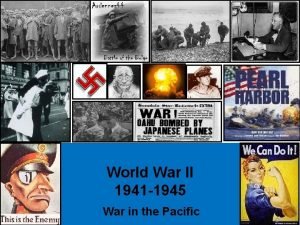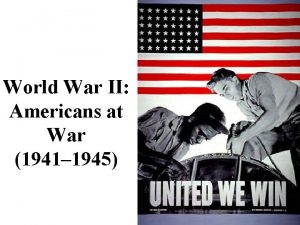World War II The Great Patriotic War 1941
















































- Slides: 48

World War II: The Great Patriotic War (1941 -1945)

I. l Pre-War Developments: Nazi-Soviet Pact Throughout the 1930’s, the Soviet Union looked to actively oppose the rising strength of the Fascists in Germany and Italy - “Popular Fronts” – Communist Parties were instructed to cooperate with Governments actively opposed to Fascist aggression - The only major country to aid the anti-Fascists in the Spanish Civil War (1936 -1939) - Was willing to defend Czechoslovakia as per their agreement in 1934 / France was not. USSR & Czechoslovakia were not even invited to the Munich Conference • Germany & Japan signed anti-Comintern Pact against the USSR in 1936. Italy and Spain joined in 1937 & 1939.

I. Pre-War Developments: Nazi-Soviet Pact l Only after Germany’s annexation of all of Czechoslovakia did Great Britain & France show interest in building an anti-German alliance with the USSR: - They sent a low-ranking mission to Moscow indicating the lack of seriousness of the mission (Spring, 1939)

I. Pre-War Developments: Stalin’s Assessment of European Relations on the Eve of the Nazi-Soviet Pact l Given a choice between a non-aggression pact with Britain and France or Germany in 1939, Stalin chose Germany because: 1. Alliance with Britain & France would mean war would be avoided. Based on the events of 1917 -1939, Stalin firmly believed that a successful communist revolution was impossible in peaceful conditions. 2. Non-aggression pact with Germany would mean partition of Poland Soviet borders moving 200 miles westward - Soviet acquisition of the Baltic states and Moldavia - spheres of influence in Romania, Bulgaria, and Hungary - possible sphere of influence in Yugoslavia 3. The “Sovietization” of Germany is likely only after a long, protracted war that exhausts Britain, France and Germany. 4. If Germany was victorious against Britain & France, it would not pose a threat to the USSR for at least 10 years because it would be too exhausted.

I. Pre-War Developments: Nazi-Soviet Pact l Molotov-Ribbentrop Pact (August, 1939) - Non-aggression pact - Germany was free to fight in the West / Soviet Union bought time to build up its defenses - a secret protocol allowed the Soviet Union to annex the Baltic states and occupy eastern Poland (Belorussian and Ukrainian territory taken by the Poles during the Russian Civil War in 1921). - 1940: The Soviet Union also annexed territory from Romania and formed the Moldavian Soviet Socialist Republic.

Development of the Soviet Armed Forces, 1939 -1941 January 1, 1939 131. 5 June 22, 1941 316. 5 % increase 2, 485, 000 5, 774, 000 132. 4 Guns and mortars Tanks 55, 800 117, 600 110. 7 21, 100 25, 700 21. 8 Aircraft 7, 700 18, 700 142. 8 Divisions calculated Personnel 140. 7

I. Pre-War Developments: The Soviet-Finnish War (1939 -1940) l The Soviet Government requested that the Finns give up some of its territory near Leningrad, the second largest city inn the USSR, in exchange for a much larger area further north (Karelia). l The Soviets were anxious to defend Leningrad and keep the Gulf of Finland free of German and enemy ships. l A border incident where Finnish forces shelled Soviet border forces sparked the war. (Nov. – Feb. )

I. Pre-War Developments: The Soviet-Finnish War (1939 -1940) l The much smaller Finnish Army fought very well, inflicting large losses on the Red Army. l http: //militera. lib. ru/research/meltyukhov/i ndex. html l http: //militera. lib. ru/research/index. html

II. The Outbreak of the War: Why Did Nazi Germany Want War with the USSR? 1. Eastward colonial expansion - Liebensraum for German farming settlers - Raw materials and food produce from Ukraine, Russia. - Soviet industries would be dismantled / the population would be worked to death by the Nazis. - Russians, Ukrainians, Belorussians (Slavs) were subhumans and barbarians not worthy of being civilized

II. Nazi Racial Theory Regarding the Peoples of the USSR 1. 2. 3. 4. 5. According to Nazi racial theory, Slavs (Russians, Ukrainians, Belorussians) were subhuman. Armenians biologically were related to Jews Soviet Asians – “inferior Mongols” Georgians & Estonians – Aryans Latvians & Lithuanians – fit for “Germanization”

II. The Outbreak of the War: Why Did Nazi Germany Want War with the USSR? 2. Bolshevism – a “Jewish-Slavic conspiracy” against the German race. - Hitler wrote extensively in “Mein Kampf” his hatred of Jews. The Jews were responsible for Communist ideology (Marx was a Jew) that looked to destroy German culture in favor of “proletarian internationalism” - The Slavs were barbarians duped by the Jewish Bolsheviks

II. The Outbreak of the War: The Warnings l Soviet authorities received many accurate warnings of the coming attack from: - diplomatic, military, and intelligence channels from Soviet as well as Western sources. - Winston Churchill and Franklin D. Roosevelt DIRECTLY warned Stalin of the impending attack - German deserters - even the GERMAN AMBASSADOR to the Soviet Union! • Stalin believed this was all Western disinformation that tried to provoke the USSR into war with the Nazis. Stalin and his inner circle mistrusted Hitler, but mistrusted Roosevelt & Churchill even more.

II. The Outbreak of the War: The Warnings Friedrich-Werner Graf von der Schulenburg (1875 -1944) • • Named German ambassador to the Soviet Union in 1934. Favored good relations with the Soviet Union. Played an important role bringing about the Nazi-Soviet Pact. Warned the Soviet Ambassador to Berlin about the coming Nazi attack on the USSR: • “My ambassador, perhaps this has never yet taken place in the history of diplomacy, but I intend to reveal to you state secret number one: pass this on to Mr. Molotov, and I hope he will inform Mr. Stalin; Hitler has decided on 22 June to start a war against the USSR. You ask, why am I doing this? I was brought up in the spirit of Bismark, and he was always against war with Russia. ” • Schulenburg was executed in 1944 for being part of a plot to assassinate Hitler.

II. The Outbreak of the War: The Repression in the Red Army of the Red Army The losses as a result of the Purges in the military were staggering: • • • 3 of the 5 Marshals 15 of the 16 army commanders All of the corps commanders Almost all division and brigade commanders 1937 -1938: the Purge in the Soviet Army led to the loss of 15, 000 officers, about 10 -15% of the total. • 1940: of the 225 regional commanders on active duty: - not 1 was educated in a military academy - 25 finished a military school - remaining 200 had only completed the course for junior • At the beginning of 1940 - more than 70% of the divisional commanders - about 70% of the regimental commanders had occupied these positions for only a year lieutenants

The Destruction of the Soviet High Command • The Soviet Marshals: Tukhachevsky, Voroshilov, Yegorov, Budenny, Blyuher. Only Voroshilov and Budenny survived the Purges of 1937 -1938.

II. The Outbreak of the War l June 22, 1941 – Germans launched Operation Barbarossa – the attack on the Soviet Union - Largest land-air invasion in military history: 190 divisions (5. 5 million troops) of German, Romanian, Finnish, Hungarian, Slovakian and Italian troops along a 2, 000 mile front - 4, 000 tanks / 5, 000 aircraft, 47, 000 artillery pieces 200 warships - The entire Eastern Front was 3, 720 miles long. • After the invasion took place, Stalin disappeared from public view for more than a week.

Operation Barbarossa

II. The Outbreak of the War: The Fronts l 3 Main Fronts of the War: German Army Group North > Leningrad 2. German Army Group Center > Moscow 3. German Army Group South > Kiev, Rostov-on-Don 1.

II. The Outbreak of the War: The Siege of Leningrad

II. The Outbreak of the War: The Siege of Leningrad 1. Army Group North > Leningrad / The Siege of Leningrad - By September 8, 1941 the Germans had fully encircled Leningrad and the blockade began. - The siege lasted for a total of 900 days, from September 8 1941 until January 27 1944. - The city's almost 3 million civilians (including about 400, 000 children) refused to surrender and endured rapidly increasing hardships in the encircled city. - In January 1942 in the depths of an unusually cold winter, the city's food rations reached an all time low of only 125 grams (about 1/4 of a pound) of bread person per day. - In just two months, January and February of 1942, 200, 000 people died in Leningrad of cold and starvation. Despite these tragic losses and the inhuman conditions the city's war industries still continued to work and the city did not surrender. - Several hundred thousand people were evacuated from the city across Lake Ladoga via the famous "Road of Life" - Dmitry Shostakovich wrote his Seventh "Leningrad" Symphony and it was performed in the besieged city. - In January 1943 the Siege was broken and a year later, on January 27 1944 it was fully lifted. At least 641, 000 people had died in Leningrad during the Siege (some estimates put this figure closer to 800, 000).

II. The Outbreak of the War: The Fronts 2. Army Group Center > Moscow - The Germans aimed their main blow at Moscow. Hitler increased his and his allies divisions to 240 and made an all-out push to capture the Soviet capital. - By November, 1941, The Germans encircled the city on three sides and they came within 20 miles of it but never captured it. - In late-November, the first successful Soviet counteroffensive led by Marshal Georgy Zhukov resulted in the successful defense of Moscow.

II. The Outbreak of the War: The Fronts 3. Army Group South. Kiev, Rostov-on-Don - Entire Soviet armies were smashed and taken prisoner at Bialystok, Minsk and Kiev. - As a result of early German successes, 40% of the Soviet population, half of its industrial output and a third of its food production where under its control. - Nazi troops advanced up to 155 miles by June 25 and 372 miles by July 10, 1941.

II. The Outbreak of the War: German Losses l In the first four months of the Great Patriotic War: - over 500, 000 officers and soldiers. The Nazis lost a total of 300, 000 troops in the first two years of WWII. - Although the Germans occupied much Soviet territory, they failed to take Leningrad, Moscow or the rich oil reserves in the Caucasus.

III. Soviet and German Offensives, 1942 December, 1941 – April 1942 • Soviet counter-offensive in December pushed German troops between 62 -155 miles from Moscow. - However, they failed to achieve their overall objectives of lifting the siege of Leningrad, smash the three main German Army groups and to clear German troops out of Crimean and the Donbass. • Overall, between January & April 1942, Soviet forces advanced some 186 -248 miles to the west. - The Germans lost between 400, 000 -800, 000 men - The Soviets lost an average of 19, 000 people a day. - More than 50 Soviet generals were taken prisoner in the first year of the war.

III. Soviet and German Offensives, 1942 Summer – Fall, 1942 • The Germans launched an offensive with 2 main goals in mind: 1. capture the oil fields in southern Russia (the Caucasus) 2. capture Stalingrad

III. Soviet and German Offensives, 1942 1. The Caucasus Front - Before the Caucasus offensive, the Germans recaptured all of the Crimea (Sevastopol), taking 90, 000 Soviet prisoners. They also retook the Donbass, capturing 200, 000 more Soviet soldiers. - Germans desire to capture Soviet oil fields failed partly as a result of the fierce fighting at Stalingrad. - Red Army halted German advances in December. January, 1943 they launched a counter-attack. - Soviets killed 200, 000 German troops and destroyed approximately 900 tanks and 2, 000 aircraft.

III. Soviet Counter-Offensive, 1942 -1943 2. Battle of Stalingrad • Hitler wanted to capture Stalingrad because it bore the Soviet leader’s name. • The battle was waged for over 200 days and nights / the fiercest battle in all of the War • The Germans surrendered on February 2, 1943. This was the first major loss the Germans experienced during the war: - German losses: about 800, 000 - Soviet losses: about 1, 080, 000 • Turning point of WWII for the Allies.

III. Allies in Action During the Battle of Stalingrad: 1942 -1943 l October 1942 – British under General Montgomery defeated the Germans in El Alamein in North Africa. - The victory resulted in 55, 000 German and Italian deaths and the destruction of 320 tanks and nearly 1, 000 pieces of artillery. • Compared to Stalingrad where the Germans had over 1 million soldiers in battle, at El Alamein, less than 100, 000 German and Italian forces opposed the British.

IV. From Stalingrad to the Liberation of the Soviet Union

IV. From Stalingrad to the Liberation of the Soviet Union Summer, 1943 – Battle of Kursk • In the absence of a second front in Europe, Hitler sent massive reinforcements (200 divisions in total) to the Eastern Front. • The largest tank battle in the history of warfare began on July 5, 1943: - 1. 3 million Soviet soldiers 3, 444 tanks, 2, 900 aircraft, 19, 000 guns faced 900, 000 Germans with 2, 700 tanks, 2, 000 aircraft, and 10, 000 guns. • The fighting lasted for 50 days: - The Red Army won / heavy casualties - German forces lost 30 divisions including 7 armored divisions: 500, 000 men, and almost 1, 500 tanks.

IV. From Stalingrad to the Liberation of the Soviet Union l Between August and December 1943, the Red Army liberated most of central Russia and the Ukraine. l 200, 000 German & Romanian troops were trapped in the Crimea. l By the end of 1943, the Germans lost 2/3 of the territory they had occupied since June, 1941.

IV. From Stalingrad to the Liberation of the Soviet Union 1944 became known as the year of Stalin’s “ten great victories. ” 1. 2. 3. 4. 5. 6. 7. 8. 9. 10. The relief of Leningrad (January) The encirclement of German troops in south-west Ukraine and entry into Romania (Feb. -Mar. ) The destruction of German forces in the Crimea (May) The defeat of Finnish forces and re-establishment of the 1940 frontier (June) Liberation of Belorussia (Belarus), including the destruction of 25 German divisions (June) The entry of Soviet forces into Poland against fierce resistance (July) The liberation of Romania and Bulgaria (August) The liberation of Latvia and Estonia (September) The liberation of Belgrade, Yugoslavia (October) The expulsion of German troops from northern Finland Norway (October)

V. The Road to Berlin Poland – Liberation of Warsaw (Jul. 1944 – Sept 1945) • Soviet forces under Konstantin Rokossovsky reached the Vistula River across from Warsaw in July 1944. • Soviet forces stopped their advance. • Warsaw’s underground resistance rose up against the Germans, anticipating Soviet help. Soviet response to why there was no help given to the Poles was that the Red Army needed to rest after heavy advances. • 300, 000 Poles were killed resisting the Nazis. • Soviet forces liberated Warsaw in January, 1945.

V. The Road to Berlin l Operation Overlord – Allied invasion of Normandy (June, 1944) - the Second Front that Stalin was calling for from the Allies - Anglo-American forces crossed the English Channel, capturing a vital beachhead in Normandy. • In the winter / spring of 1943 -1944, the Wehrmacht’s mounting losses in the East forced the German High Command to send some 40 additional divisions to the Soviet front. - By the time of the landing in France, almost 75% of the divisions of the Nazi bloc countries were fighting in the East.

V. The Road to Berlin l April 1945 began the Battle for Berlin - More than 6, 000 tanks, 8, 000 aircraft and 40, 000 guns of all types were used by the Red Army. • April 25, 1945, Soviet forces crossed the Elba River and established contact with units of the American First Army.

Soviet Flag Hoisted Over the Reichstag – May, 1945

VI. The Cost of Victory – The Fighting 1. The Soviet forces never faced less than 90% of German frontline combat strength on land. 2. The Eastern Front saw: - the largest artillery battle (Stalingrad) - the largest tank battle (Kursk) - the largest single land operation (Barbarossa)

VI. The Cost of Victory – The Human Toll 1. In the winter of 1941 -1942, more Leningraders starved to death every month as a result of the German siege than the total of British civilians killed by German bombs in the entire war. - the 1 million premature deaths in this one city exceeded the combined military and civilian casualties of the British Empire and the United States. 2. Between 50 -60 people died worldwide as a result of WWII – half were Soviet citizens. - 27 -30 million Soviet citizens died - 5. 7 million Soviet prisoners of war fell into German hands. As many as 4. 7 million died. 3. 60% of the Red Army was comprised of peasants. They bore the brunt of the fighting casualties.

VI. The Cost of Victory – The Economic Toll 1. Roughly 30% of the pre-war economy had been destroyed. - In the occupied territories (Ukraine, Belarus, Russia) up to 2/3 of the economy was destroyed. 2. The Germans completely or partially destroyed and burnt: - 1, 710 towns and settlements and more than 70, 000 villages and hamlets - 6 million buildings and rendered homeless about 25 million people - destroyed 31, 580 industrial enterprises - decomissioned metal works that accounted for 60% of the country’s steel and mines yielding more than 60% of the country’s coal - destroyed 65, 000 kilometers of railroads and 4, 100 stations - destroyed 36, 000 post and telegraph installations, telephone exchanges and other communications enterprises - slaughtered, seized, or drove back to Germany 7 million horses, 17 million cattle and oxen, 20 million pigs, 27 million sheep and goats. - destroyed and looted 40, 000 hospitals and other medical establishments - destroyed and looted 84, 000 schools, colleges, universities, research institutes and 43, 000 libraries.

VII. Reasons for Soviet Victory 1. The evacuation of industries and capital assets out of reach of the Germans (east of the Ural Mountains and Central Asia) - 1, 523 large-scale key and military industries were evacuated or 10% of the country’s net capital stock - led to a mini industrial revolution in places like Kazakhstan and Uzbekistan - The results of the industrial evacuation were critical: it supplied the Red Army with the equipment necessary to survive through Stalingrad and win there. 2. The Third Five Year Plan had the Soviet economy producing a wide range of weapons exceeded only by Germany. 3. The war was seen as a war for defense of the motherland / patriotic, not communist goals - Stalin referred to heroes of the Russian past - met with the leader of the Russian Orthodox Church and allowed it to openly operate

The Russian Orthodox Church During the Great Patriotic War

VII. Reasons for Victory: The Evacuation of Industries • The government ordered a project to recommission the big Zaporozhstal’ steel works from the Ukraine to Chebarkul’, near Chelyabinsk in the Urals – a job which, under prewar circumstances, might have taken years. They were given seventy-five days, from the end of December, 1941 to mid-March, 1942. They had to reestablish seven main and eleven auxiliary production shops together with railway lines, water supplies, air shafts; all of this in 45 degree weather, with the soil frozen to the depths of two meters. They had to heat the ground, drill it and break it up with explosives, keep the concrete from freezing, working round the clock, often holding production conferences at 2 and 3 a. m. The job was finished ahead of schedule, in six weeks. - Barber and Harrison, “The Soviet Home Front: 1941 -1945, pg. 139

VII. Reasons for Soviet Victory 4. The heroism of the Soviet people - the soldiers - the Partisans - the women, children and old-aged who worked in the factories and the farms replacing the able-bodied men called to the front

VII. Reasons for Soviet Victory 5. The superiority of the Soviet Commanders - Georgiy Zhukov – planned or commanded every major Soviet victory in WWII (Leningrad, Moscow, Stalingrad, Kursk, liberation of the USSR, Berlin) Zhukov Rokossovsky Timoshenko Konev Vasilevsky Malinovsky

VII. Reasons for Soviet Victory 6. Allied Help - Soviet Union received aid from the United States through Lend-Lease. A smaller amount came from Great Britain. - Aid arrived by 3 main routes: a) Arctic convoys up the coast of Scandinavia to the White Sea and the Soviet ports of Arkhangelsk & Murmansk b) Land route through Iran (brought under Allied occupation Aug. -Sept 1941) over the mountains into Soviet Central Asia c) Far East – From Alaska across the Bering Straits

VII. Reasons for Soviet Victory l Lend-Lease meant: - thousands of aircraft, tanks, trucks and jeeps - 1. 3 million tons of machinery & industrial equipment - 6 million tons of steel & non-ferrous metals - 4 million tons of foodstuffs - 15 million pairs of army boots - chemicals & petrochemicals - $ 10 billion worth of aid or 4% of overall Soviet production. • The majority of this aid came AFTER the Soviet defeat of Nazi forces at Stalingrad. Soviet domestic production contributed to the defense of the country and the victory at Stalingrad. Allied aid contributed to the speedier defeat of the Nazis. • What the Allies paid for in weapons and material aid, the Soviets paid for in blood.

VIII. Liberation of Holocaust Survivors l The Red Army liberated most of the concentration camps located in eastern Europe while American, British, Canadian and French forces liberated concentration camps in northern and western Germany. l Major concentration camps liberated by the Red Army: 1. Auschwitz-Birkenau – the largest concentration camp 2. Majdanek 3. Chelmno 4. Sachsenhausen 5. Ravensbrueck 6. Stutthof

VIII. Jews in the Red Army l More Jews served in the Red Army than any other Allied army in World War II (501, 000 / 1939 prewar Jewish population was 3 million). - 167, 000 officers / 276 Generals and Admirals / 334, 000 enlisted men) - 198, 000 died fighting - 160, 772 received awards & medals - 149 – Hero of the Soviet Union - 25, 000 Jewish Partisans fought in Ukraine - 30, 000 Jewish Partisans fought in Belarus l Anatoly Shapiro, the first Soviet officer to lead his troops into Auschwitz when it was liberated, is Jewish. - "I was very proud of being in the vanguard of the liberators, not so much because I was a Jew liberating the camp, but because we, the Red Army, liberated it. " - "The Soviet Union has disappeared, but these medals remain. I
 Great patriotic war period
Great patriotic war period A world in flames 1931-1941
A world in flames 1931-1941 United indian patriotic association in hindi
United indian patriotic association in hindi Patriotic tear
Patriotic tear Bullets smacking the belly out of the air
Bullets smacking the belly out of the air Patriotic poem by sarojini naidu
Patriotic poem by sarojini naidu 1965-1874
1965-1874 The great war: the world in upheaval
The great war: the world in upheaval 1941-1882
1941-1882 1941-1882
1941-1882 Pintor das mulatas
Pintor das mulatas Suicide note virginia woolf
Suicide note virginia woolf 1978-1941
1978-1941 1941-1882
1941-1882 Giorgio joyce
Giorgio joyce 1941-1882
1941-1882 1882-1941
1882-1941 1941-1882
1941-1882 Salvador dali autoportrait avec bacon
Salvador dali autoportrait avec bacon 1941-1882
1941-1882 1941-1882
1941-1882 1941-1882
1941-1882 1941-1882
1941-1882 James joyce birthplace
James joyce birthplace 1941-1882
1941-1882 1941-1882
1941-1882 1941-1882
1941-1882 1941-1882
1941-1882 1941
1941 1941
1941 Nicolas weissberg
Nicolas weissberg 1941
1941 Prosinec 1941
Prosinec 1941 Kode kentongan
Kode kentongan “ho hum!” political cartoon by dr. seuss, 1941
“ho hum!” political cartoon by dr. seuss, 1941 Arcadia conference 1941
Arcadia conference 1941 Hình ảnh bộ gõ cơ thể búng tay
Hình ảnh bộ gõ cơ thể búng tay Lp html
Lp html Bổ thể
Bổ thể Tỉ lệ cơ thể trẻ em
Tỉ lệ cơ thể trẻ em Voi kéo gỗ như thế nào
Voi kéo gỗ như thế nào Tư thế worms-breton
Tư thế worms-breton Hát lên người ơi
Hát lên người ơi Các môn thể thao bắt đầu bằng tiếng chạy
Các môn thể thao bắt đầu bằng tiếng chạy Thế nào là hệ số cao nhất
Thế nào là hệ số cao nhất Các châu lục và đại dương trên thế giới
Các châu lục và đại dương trên thế giới Cong thức tính động năng
Cong thức tính động năng Trời xanh đây là của chúng ta thể thơ
Trời xanh đây là của chúng ta thể thơ Mật thư tọa độ 5x5
Mật thư tọa độ 5x5
